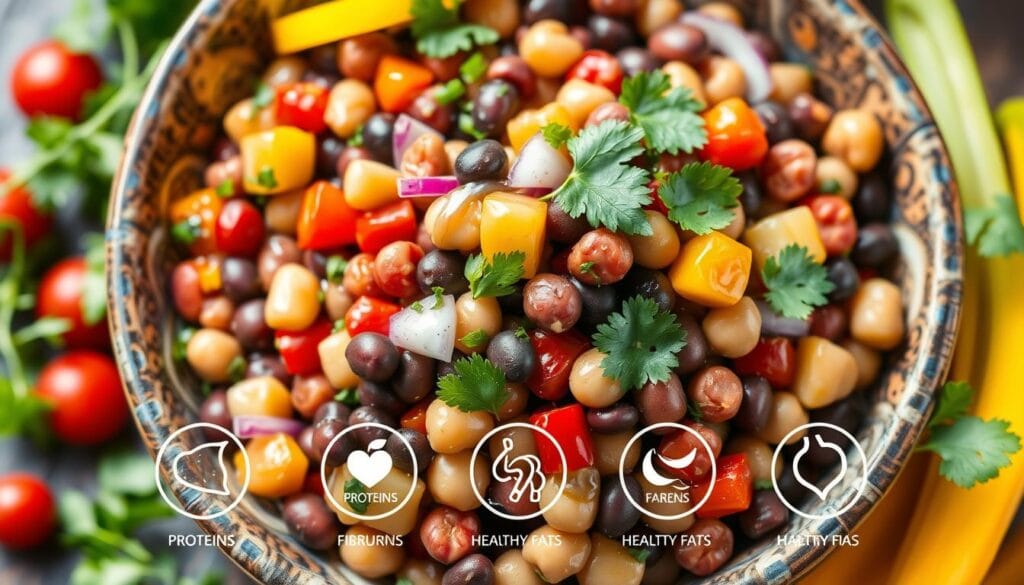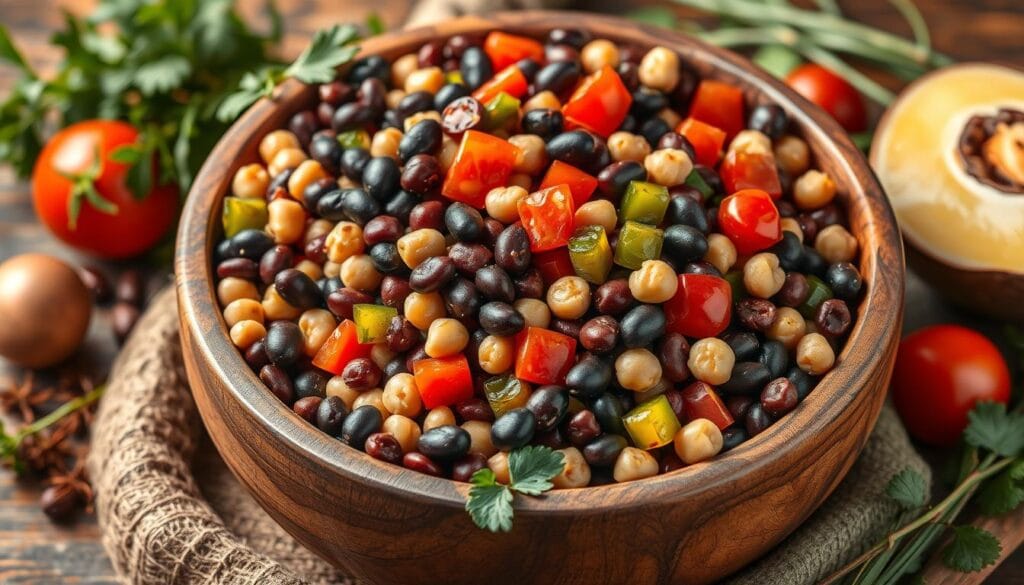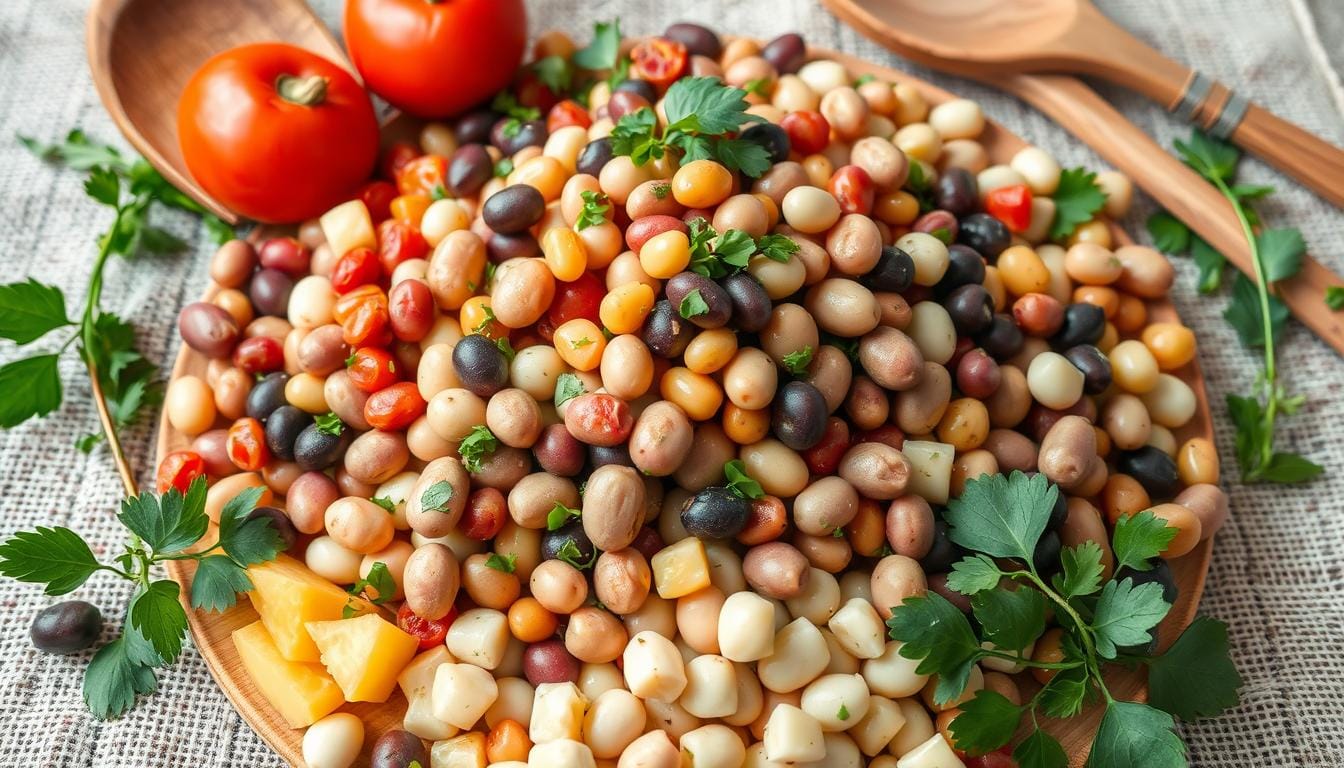Ever stared at a bowl of dense bean salad, wondering about its magic? My journey into bean salads started on a crisp autumn afternoon. A simple dish changed how I see nutrition and flavor.
The dense bean salad is more than a side dish. It’s a nutritional powerhouse that tells a story of culture and diet. From its origins to the detailed preparation, it’s a delicious mix of health and taste.
What makes a bean salad dense? It’s the carefully chosen ingredients that offer a lot of nutrients, fiber, and flavor. The history of dense salads shows a rich mix of culinary traditions that have made this dish so special.
Key Takeaways
- Dense bean salads are nutrient-rich culinary masterpieces
- Calorie density plays a crucial role in meal satisfaction
- Bean varieties significantly impact the salad’s nutritional profile
- Cultural traditions deeply influence bean salad preparation
- Nutritional value extends beyond basic calorie counting
Understanding Calorie Density in Bean Salads
Exploring bean salad nutrition shows us a key concept: calorie density. It’s called dense because these dishes pack lots of nutrients without many calories.

Calorie density is about how much food you eat versus how many calories it has. Bean salads are a great example of foods that are full of nutrients but low in calories. This is because they have lots of water, fiber, and important nutrients.
The Science Behind Food Volume and Calories
Looking at bean salad nutrition, here are some important points:
- Beans give you a lot of volume but not many calories
- They have a lot of water and fiber, making you feel full
- They are packed with nutrients, making them very valuable
Water and Fiber Content in Dense Salads
“A dense bean salad is not just about calories, it’s about nutritional power packed into every bite.”
Beans have a lot of water and fiber, making them special. For example, a serving of Mediterranean Dense Bean Salad has:
- 22g of protein
- 16g of dietary fiber
- 21g of healthy fats
Nutritional Value Per Serving
Your bean salad is more than just a side dish. It’s a nutritional powerhouse. It has lots of vitamins and minerals, like 1943IU of Vitamin A and 247mg of calcium. It helps keep your calorie intake low while boosting your health.
Understanding calorie density helps you choose better foods. These foods are not only tasty but also good for you.
Why is it called a dense bean salad?

The term dense bean salad comes from a trend that combines lots of nutrition in a small dish. Social media stars like Violet Witchel helped make it popular. They showed how it’s great for those who want healthy, filling meals.
The name comes from the high nutritional value of beans. Just half a cup can give you a lot of health benefits. This salad style is known for being a nutrient-packed, filling option with few ingredients.
“Nutrition is about quality, not just quantity” – Nutrition Expert
- Nutrient Concentration: Beans provide essential nutrients in a small volume
- High Fiber Content: Half cup contains approximately 6 grams of fiber
- Mineral Rich: Offers 10% daily needs for potassium and magnesium
| Nutrient | Amount per 1/2 Cup | Daily Percentage |
|---|---|---|
| Fiber | 6 grams | 24% |
| Potassium | 475 mg | 10% |
| Magnesium | 60 mg | 14% |
Only 7 percent of U.S. adults get enough fiber. Dense bean salads are a tasty way to fill this nutritional gap. TikTok creators like Witchel have made these Mediterranean-inspired dishes very popular, getting millions of views.
The Historical Evolution of Bean-Based Dishes
Bean salads have a long and interesting history that spans centuries and continents. They originated in ancient times when legumes were a key food. Each culture had its own way of making these dishes, using local ingredients and cooking methods.
The history of dense salads shows how different regions have their own ways of making them. These dishes have become complex and flavorful, showing off local ingredients and cooking skills.
Cultural Significance Across Different Cuisines
Bean-based dishes are very important in many cultures. They are:
- Affordable protein sources for communities
- Traditional celebration foods
- Symbols of agricultural heritage
- Nutritional cornerstones in regional diets
Traditional Preparation Methods
Each region has its own creative way of making bean salads. From slow-cooked Mexican dishes to Mediterranean salads with herbs, each tells a unique story.
“Beans are not just food; they are a connection to our cultural roots and agricultural traditions.” – Local Food Historian
Regional Variations and Influences
Different places have their own special bean salad styles. These are shaped by local ingredients and cooking ways. Here are some examples:
| Region | Signature Bean Salad Style | Key Ingredients |
|---|---|---|
| Mediterranean | Herbed Chickpea Salad | Chickpeas, parsley, olive oil |
| Latin America | Black Bean Salsa | Black beans, cilantro, lime |
| Middle East | Fava Bean Salad | Fava beans, cumin, tahini |
Learning about the history of bean salads helps us see their value. They show cultural exchange, agricultural progress, and culinary creativity that keeps growing.
Components That Make a Bean Salad Dense
Making a dense bean salad is more than just mixing stuff together. It’s about picking the right ingredients for flavor, nutrition, and texture. This way, your salad becomes a real health boost.
The heart of a dense bean salad is the protein-rich beans. These are the main players in your dish. Some top choices include:
- Kidney beans
- Chickpeas
- White beans
- Black beans
- Butter beans
Choosing the right ingredients is key to a rich taste. The famous Mediterranean bean salad on TikTok shows how mixing things up can make a big difference.
“A great dense bean salad is about layering flavors and textures” – Alexandria Drzazgowski, The Foreign Fork
You can add more to your bean salad to make it even better. Think about adding:
- Proteins: Grilled chicken, steak, or feta cheese
- Vegetables: Peppers, cucumbers, corn
- Fresh herbs: Cilantro, parsley
- Dressing: Vinegar-based or herby green goddess
The best thing about a dense bean salad is how flexible it is. You can change it up to fit any diet. It’s perfect for a quick meal or a healthy side dish.
Nutritional Benefits of Dense Bean Salads
Dense bean salads are nutritional powerhouses that can transform your diet. They offer incredible health benefits. These vibrant dishes pack a significant punch of nutrients that support overall wellness.
When exploring bean salad nutrition, you’ll discover an impressive array of health advantages. These dishes are more than just a simple side.
Protein Content and Fiber Analysis
Beans are exceptional sources of plant-based protein, offering about 15 grams per cup. This makes them an excellent choice for vegetarians, vegans, and anyone seeking alternative protein sources. The dense bean salad provides a substantial protein boost that supports muscle repair and metabolic health.
- 15 grams of protein per cup of beans
- 12-15 grams of fiber per serving
- Supports muscle recovery and satiety
Essential Vitamins and Minerals
Dense bean salads are nutritional treasure troves rich in critical vitamins and minerals. They contain essential nutrients like iron, folate, and potassium. These nutrients contribute to overall health and wellness.
“Beans are nature’s multivitamin, providing a comprehensive range of nutrients in one delicious package.”
Health Benefits for Different Dietary Needs
The health benefits of dense salads extend across multiple dietary requirements. These nutrient-dense meals can help stabilize blood sugar, support heart health, and promote weight management.
- Slowly digestible carbohydrates
- Potential to reduce bad LDL cholesterol
- Supports individuals with pre-diabetes or diabetes
By incorporating dense bean salads into your diet, you’re making a strategic choice for comprehensive nutrition and long-term health.
Comparing Calorie Density: Beans vs Other Ingredients
Beans are nutritional powerhouses that offer great value. They have a balance of calories and nutrients. This makes them stand out.
Let’s look at the calorie density of different ingredients. This will show why beans are special:
- Black beans: Approximately 114 calories per half-cup
- Almonds: 576 calories per 100 grams
- Olive oil: 884 calories per 100 grams
- Broccoli: 34 calories per 100 grams
- Carrots: 41 calories per 100 grams
“Beans provide an exceptional nutritional profile that balances calorie intake with essential nutrients.” – Nutrition Research Institute
Beans are unique because they offer a lot of nutritional benefits. One cup of cooked black beans has 335 kilocalories. It also has:
- 15.2g protein
- 15g dietary fiber
- Essential minerals like magnesium, potassium, and iron
- Important vitamins including folate and thiamin
Choosing beans means you get a food that helps with weight management. It gives you sustained energy and supports your health. All this without too many calories.
Mastering the Art of Bean Salad Preparation
Making a tasty dense bean salad takes skill and care. Your journey starts with learning the techniques that turn simple ingredients into a nutritional powerhouse.
Improving your bean salad skills involves several key steps. These steps can make your cooking better. Cooking techniques for dense salads need precision and creativity.
Selecting the Right Bean Varieties
Choosing the right beans is key for a memorable salad. Here are some top picks:
- Black beans: Rich in antioxidants
- Kidney beans: High protein content
- Chickpeas: Versatile and nutrient-dense
- Red lentils: Quick-cooking option
Proper Soaking and Cooking Techniques
Preparing beans needs careful attention. Soak dried beans overnight to cook faster and digest better. Drain and rinse them well before cooking to remove extra starch.
| Bean Type | Soaking Time | Cooking Time |
|---|---|---|
| Black Beans | 8-12 hours | 60-90 minutes |
| Chickpeas | 12-24 hours | 90-120 minutes |
| Red Lentils | No soaking required | 15-20 minutes |
Balancing Flavors and Textures
A great dense bean salad has many flavors and textures. Mix crunchy veggies, fresh herbs, and a tangy dressing with the beans.
“The secret to an exceptional bean salad lies in its complexity of flavors and textures.” – Culinary Expert
Pro tip: Add protein-boosting ingredients like rotisserie chicken, hard-boiled eggs, or plant-based options to make it more filling.
Common Mistakes in Dense Bean Salad Making
Making the perfect dense bean salad needs care and focus. Many home cooks face several key mistakes. These errors can turn a tasty dish into a letdown.
- Overcooking beans, making them mushy
- Undercooking beans, leaving them hard and tough
- Using too much high-calorie dressing
- Getting the bean to ingredient ratio wrong
“The secret to an amazing bean salad is in the details of preparation and ingredient balance.” – Violet Witchel
Nutrition experts say it’s crucial to cook beans right. Each type of bean needs a special way to cook:
| Bean Type | Protein % | Cooking Time | Preparation Tip |
|---|---|---|---|
| Chickpeas | 38% | 25 minutes | Roast for enhanced flavor |
| White Beans | 22% | 3 minutes | Brief boiling prevents mushiness |
When making your dense bean salad, remember that good prep makes a big difference. Each bean type needs special care to keep its texture and nutrition.
Avoiding these common mistakes and using smart dense salad tips will make a dish that’s more than just food. It’s a feast of flavors and health.
Enhancing Your Bean Salad’s Nutrient Density
Making a nutrient-dense salad is more than picking ingredients. You can turn your bean salad into a nutritional powerhouse. This is done by choosing the right ingredients and how you prepare them.
“Food is not just calories, it’s information that talks to your body’s cells,” – Dr. Mark Hyman
Boosting your bean salad’s nutrition starts with knowing what each ingredient can do. Black beans are a great start, with about 15 grams of protein and 15 grams of fiber per cup. They’re also full of vitamins and minerals like iron, magnesium, and potassium.
- Add colorful vegetables for increased antioxidants
- Incorporate whole grains for complementary proteins
- Use herbs and spices to boost micronutrient content
- Select healthy fats like olive oil for better nutrient absorption
Pairing black beans with vitamin C-rich foods like tomatoes or bell peppers can help. This combo improves iron absorption and boosts your salad’s nutrient value.
| Ingredient | Nutritional Boost | Key Nutrients |
|---|---|---|
| Black Beans | High Protein & Fiber | Iron, Magnesium, Potassium |
| Bell Peppers | Vitamin C | Antioxidants, Vitamin A |
| Fresh Herbs | Micronutrient Enhancement | Phytonutrients, Minerals |
Cooking methods are important too. Cooking beans from scratch helps keep nutrients and control texture. Rinsing canned beans can cut sodium by up to 40%, making your salad healthier.
FAQ
What exactly is a dense bean salad?
Why are beans considered dense in a salad?
How do dense bean salads differ from regular salads?
Are dense bean salads good for weight management?
What beans work best in a dense bean salad?
How can I make my bean salad more nutritionally dense?
What is the calorie density of beans compared to other foods?
Can dense bean salads accommodate different dietary needs?
Conclusion
Dense bean salads are a game-changer for those who care about their health. You’ve learned how these dishes can change your eating habits. They’re packed with nutrients and easy to make, perfect for busy lives.
These salads do more than just provide basic nutrition. You can mix and match beans like black, chickpeas, and kidney beans. This makes them a great choice for any diet. Plus, they’re affordable and quick to prepare, making them a great option for healthy meals.
Don’t stop exploring with bean salads. Try adding herbs, spices, and proteins to make them even better. Whether you’re a vegetarian, vegan, or just want to eat healthier, bean salads are a tasty way to do it. Enjoy the variety and flavors, and make them a regular part of your meals.

